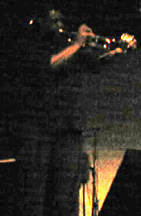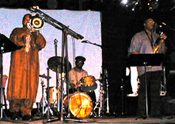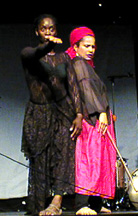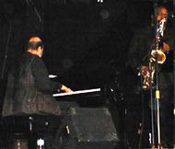| |
Tribute
To Julius Hemphill : The Fifth Annual Vision Festival
New York City, 29 May 2000
by Frank Rubolino
June 2000
For
the last three years, the Vision Festival in New York has honored,
on the last night of the concerts, a deceased member of the jazz
movement. In 1998, Jimmy Lyons was the honoree, in 1999, Denis Charles
was remembered, and this year the tribute was paid to Julius Hemphill,
the outstanding musician, composer, arranger, and teacher who died
on April 2, 1995. He was the founding father of the St. Louis Black
Artists Group and was a charter member of the World Saxophone Quartet,
for which he became the most significant arranger and compositional
contributor. His own groups were dynamic examples of innovation that
focused on his extremely diverse talent for expressing freedom through
the structure of written material. This Vision Festival tribute included
several artists who had worked with and been influenced by Hemphill,
as well as others who were inspired by him. Festival director Patricia
Nicholson and her staff are to be commended for once again assembling
a stellar lineup of creative musicians and artists who collectively
presented a rewarding remembrance of an outstanding talent.
 Baikida
Carroll has a larger-than-life presence on stage, and his trumpet
sound is equally compelling. He was a member of Hemphill's band on
Julius's first two recordings, the infectious Dogon A.D. and
its successor Coon Bid'ness (a.k.a. Reflections). For
this opening set of the Hemphill tribute, Carroll toyed with an array
of mutes to change continually the tonality of his stark playing.
He used short blasts of a few seconds each to make his statements,
all of which were devoid of frills or embellishment. He explored trumpet
sound relationships over the entire register and also used a technique
of blowing air through the mouthpiece to emit only the sound of the
lonely wind whistling down the bell of his horn. Gradually, he developed
his solo with more fluid playing that continually reverted to a theme
statement, only to spring off the theme into more extensive explorations.
The highlight of the set occurred when Carroll switched to flugelhorn
and played a mournful rendition of his hauntingly beautiful composition
"I Thought You Knew". His tribute to Hemphill evolved as an introspective
and personal expression of respect. Baikida
Carroll has a larger-than-life presence on stage, and his trumpet
sound is equally compelling. He was a member of Hemphill's band on
Julius's first two recordings, the infectious Dogon A.D. and
its successor Coon Bid'ness (a.k.a. Reflections). For
this opening set of the Hemphill tribute, Carroll toyed with an array
of mutes to change continually the tonality of his stark playing.
He used short blasts of a few seconds each to make his statements,
all of which were devoid of frills or embellishment. He explored trumpet
sound relationships over the entire register and also used a technique
of blowing air through the mouthpiece to emit only the sound of the
lonely wind whistling down the bell of his horn. Gradually, he developed
his solo with more fluid playing that continually reverted to a theme
statement, only to spring off the theme into more extensive explorations.
The highlight of the set occurred when Carroll switched to flugelhorn
and played a mournful rendition of his hauntingly beautiful composition
"I Thought You Knew". His tribute to Hemphill evolved as an introspective
and personal expression of respect.
As
a backdrop to Carroll's playing, numerous examples of the artistry
of Jeff Schlanger were projected onto a huge screen as he created
instant new art through the inspiration of Carroll's performance.
Schlanger has been a fixture at all Vision festivals, frantically
characterizing the artists and capturing the intimacy of each performance.
Watching him work is an exciting event. He paints in time with the
music, so when the sound gets wild, he is equally aggressive in pouring
paint onto his pad. Several of his pieces were on display as part
of the artistic collage Vision represents. Seeing him capture the
essence of a set in the same timeframe as the performance, however,
is a performance in itself.
 The
next dynamic trio opened their set with a powerfully rhythmic Hemphill
piece set to the driving drums of Pheeroan akLaff, the ritualistic
trombone of Joseph Bowie, and the spiraling alto of Oliver Lake. Lake,
of course, was a member with Hemphill in the World Saxophone Quartet
and also played in duet with him on Buster Bee. This performance
was a set-long reworking of the heady Hemphill composition "The Hard
Blues". The tune itself is one that elicits excitement, and in the
hands of these three veterans, it worked its magic once again. Bowie
was agile and aggressive on his trombone, blowing blasts of sound
with machinegun rapidity while akLaff took off with overtly demonstrative
drumming. Bowie augmented the percussiveness of the set by manipulating
an array of rattlers, shakers, and an African drum, providing an additional
spark to the already forceful performance. Lake's soaring solos reinforced
his status as a premier player of the new music. He alternated between
alto and curved soprano, spewing out lengthy runs with constant intensity
as he and the band interpreted the famous Hemphill composition. The
performance was an extended example of free improvisation that had
punch and power. As they brought the piece back in with the theme
statement, attendees could be seen and heard humming the engrossing
melody while the musicians built it to a peak of excitement. Hemphill
would have been pleased. The
next dynamic trio opened their set with a powerfully rhythmic Hemphill
piece set to the driving drums of Pheeroan akLaff, the ritualistic
trombone of Joseph Bowie, and the spiraling alto of Oliver Lake. Lake,
of course, was a member with Hemphill in the World Saxophone Quartet
and also played in duet with him on Buster Bee. This performance
was a set-long reworking of the heady Hemphill composition "The Hard
Blues". The tune itself is one that elicits excitement, and in the
hands of these three veterans, it worked its magic once again. Bowie
was agile and aggressive on his trombone, blowing blasts of sound
with machinegun rapidity while akLaff took off with overtly demonstrative
drumming. Bowie augmented the percussiveness of the set by manipulating
an array of rattlers, shakers, and an African drum, providing an additional
spark to the already forceful performance. Lake's soaring solos reinforced
his status as a premier player of the new music. He alternated between
alto and curved soprano, spewing out lengthy runs with constant intensity
as he and the band interpreted the famous Hemphill composition. The
performance was an extended example of free improvisation that had
punch and power. As they brought the piece back in with the theme
statement, attendees could be seen and heard humming the engrossing
melody while the musicians built it to a peak of excitement. Hemphill
would have been pleased.
 Dancer
Maria Mitchell and violinist Terry Jenoure performed a rite of theater
with music that had a unique way of remembering Hemphill as an inspiration
to their artistry. Jenoure will be familiar to all that have enjoyed
the exciting John Carter five-part suite entitled Roots and Folklore:
Episodes in the Development of American Folk Music. Her violin
and voice are dominant on that wonderful collection, and the same
magnetism came through with her performance with Mitchell. Mitchell
is a daring, freelance interpretive dancer who lithely flies through
the air with venturesome moves and intimidating gestures. She and
Jenoure entered into a game of cat and mouse as Mitchell toyed with
the violinist through her dance movements. She cajoled and taunted
until there was a meeting of the minds and bodies. Jenoure's playing
was soulfully spiritualistic, soaring in unison with her beautiful
voice that accompanied her strings. Mitchell's moves were in keeping
with her stark demeanor—challenging and defiant while simultaneously
being extremely graceful. She turned and twisted her supple body while
Jenoure spurred the action with emotional playing. The two women formed
a very artistic team while seamlessly uniting, into one, the three
art forms of dance, music and theater. Dancer
Maria Mitchell and violinist Terry Jenoure performed a rite of theater
with music that had a unique way of remembering Hemphill as an inspiration
to their artistry. Jenoure will be familiar to all that have enjoyed
the exciting John Carter five-part suite entitled Roots and Folklore:
Episodes in the Development of American Folk Music. Her violin
and voice are dominant on that wonderful collection, and the same
magnetism came through with her performance with Mitchell. Mitchell
is a daring, freelance interpretive dancer who lithely flies through
the air with venturesome moves and intimidating gestures. She and
Jenoure entered into a game of cat and mouse as Mitchell toyed with
the violinist through her dance movements. She cajoled and taunted
until there was a meeting of the minds and bodies. Jenoure's playing
was soulfully spiritualistic, soaring in unison with her beautiful
voice that accompanied her strings. Mitchell's moves were in keeping
with her stark demeanor—challenging and defiant while simultaneously
being extremely graceful. She turned and twisted her supple body while
Jenoure spurred the action with emotional playing. The two women formed
a very artistic team while seamlessly uniting, into one, the three
art forms of dance, music and theater.
No
greater tribute could be paid to Hemphill than through the perpetuation
of his music by a band he conceived and nurtured. The Julius Hemphill
sextet grew out of Hemphill's departure in 1990 from the World Saxophone
Quartet and brought a different aspect to all-reed ensembles. They
made three albums, one with Hemphill in 1991 (Fat Man and the Hard
Blues), one directed by Hemphill in 1994 (Five Chord Stud),
and the third in 1997 as a commemorative after Hemphill's death (At
Dr. King's Table). The band reunites irregularly to keep his music
in the forefront, and on this evening, they were at their sparkling
best. With original members Marty Ehrlich, Sam Furnace, and Andrew
White plus Andy Laster, Alex Harding, and Aaron Stewart, the sextet
captivated a very large crowd that was put into the spirit of gaiety
and happiness through the execution of Hemphill's songs by this stellar
cast.
The band uses a structured facade as a gateway to more riotous blowing.
Individual soloists expound and give way to collective improvisation.
Ehrlich, on alto, soprano, and bass clarinet, appears to be the traffic
director, but little direction is needed for this group of pros. They
are a disciplined bunch who ignite at any instant with spontaneous
interaction. White was a significant factor and a scene-stealing showman
who pleased the crowd as he wailed on tenor while Harding huffed and
puffed on baritone in playful combat. The group often broke down into
duet or trio formats and then reformed with sextet thunder. They hit
a spiritual high when all six collectively improvised, bringing fire
and brimstone to the bandstand. They pranced through a series of Hemphill
tunes, including among others "Otis' Groove", "Flush", "What I Know
Now", "Mirrors", "Spiritual Chairs", and exploded on "The Void", an
evolving freeform piece of collective interaction that emerged from
a structured opening. Everyone had a moment in the spotlight. Laster
shined on alto with a lengthy solo, Furnace burned on his alto, Stewart
did the same on tenor, and so it went for the entire set. The highlight
of the performance was the riotous "Dogon A.D.", a tune that defies
you to sit still. The band paraded through the audience playing the
ritual piece while the crowd roared admiringly. As an encore, they
did a short ballad that summed up the beauty of Hemphill's music.
It was a wild and delightful set put on by dedicated musicians.
 David
Murray and Dave Burrell were reunited for a fitting closing to the
Hemphill tribute and the 11-day Vision Festival. Murray said it had
been over three years since they played together, but the magic they
generated in the past was easily recaptured. Murray was in a feisty
mood on this night. He opened with one of his compositions by blowing
fiercely in the high register to set the radical stage. Burrell, a
seemingly mild-mannered man, had the opposite composure. He played
his methodical block chords to start a composition of his and took
the theme deeper and deeper into a hypnotic world with highly resonant
playing that emphasized the bottom end of the sound spectrum. His
pounding became more aggressive, and he used his fists and palms to
maintain the deep, droning, and dark impression. On another tune,
Burrell played the bass line with his left hand and tinkered with
a blues-syncopated beat with his right. Whereas Burrell waltzed with
lilting phrases true to his style, Murray was aggressive and agitated,
playing with fiery drive. The collision of these opposites made the
music significant, allowing each to express himself in his own way. David
Murray and Dave Burrell were reunited for a fitting closing to the
Hemphill tribute and the 11-day Vision Festival. Murray said it had
been over three years since they played together, but the magic they
generated in the past was easily recaptured. Murray was in a feisty
mood on this night. He opened with one of his compositions by blowing
fiercely in the high register to set the radical stage. Burrell, a
seemingly mild-mannered man, had the opposite composure. He played
his methodical block chords to start a composition of his and took
the theme deeper and deeper into a hypnotic world with highly resonant
playing that emphasized the bottom end of the sound spectrum. His
pounding became more aggressive, and he used his fists and palms to
maintain the deep, droning, and dark impression. On another tune,
Burrell played the bass line with his left hand and tinkered with
a blues-syncopated beat with his right. Whereas Burrell waltzed with
lilting phrases true to his style, Murray was aggressive and agitated,
playing with fiery drive. The collision of these opposites made the
music significant, allowing each to express himself in his own way.
Although the two took turns playing their own compositions, their
featured song was in salute to Hemphill on Murray's "Requiem for Julius".
It was a beautifully executed ballad that brought out all the passion
and emotion Murray had contained in him. Burrell established the rhythmic
pulse while Murray, on bass clarinet, reached into his inner soul.
The two were on stage for over 80 minutes in an extra-long set. In
between songs, Murray and Burrell took the mike to reiterate short
vignettes on their association together. Murray also took an expressive
position on the relationship of Hemphill and the WSQ. He made a bold
assertion that the separation was financially equitable and that there
were two sides to every story. Most were amazed that he even broached
the subject, but he said he wanted to set the record straight on Hemphill's
departure from the band. Still, he did not reveal all the scuttlebutt.
His most moving statements were in high admiration for the genius
that was Hemphill. There was no question on his sincerity on this
matter.
It was the music, though, that captivated the late-night crowd, and
Murray and Burrell showed that old spark that has made each of their
prior unions significant. It was a moving way to culminate the festival.
|
|
|
|
|

